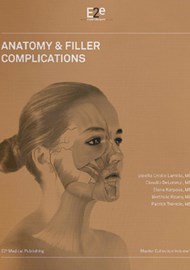A book with a calming light brown covering is what is needed when faced with an adverse event. This book covers the underlying anatomy and filler complications that may occur in clinical practice. Arranged in five chapters it is an incredibly easy book to read and understand; the authors have done a great job in ensuring readers are able to follow the discussions and relate it to the clinical conditions encountered. It is also impressive that the chapters are referenced with relevant current peer-reviewed articles.
Claudio DeLorenzi opens with the introduction and the first chapter that sets the scene and has managed to arrange filler complications into a logical and straightforward format. This is carried on within the following chapters and allows the reader to apply the complications classification that these authors have proposed into a clinically relevant pathway. The main chapters of this book are beautifully photographed and illustrated, and the second chapter focuses on anatomical areas of clinical significance to injectors. The discussion and descriptions by Patrick Trevidic and Gisella Criollo Lamilla cover the relevant anatomical areas in depth and lays out a very clear anatomical discourse that all practitioners will find useful. If anything else this is a chapter that should be read over to get a thorough understanding.
The following two chapters by Claudio DeLorenzi and Berthold Rzany covering vascular complications and other unwanted complications are an up-to-date discussion of the current treatment pathways for these problems. Both of these international experts have laid out the clinical problems and provide a concise explanation on causation, with prevention and specific advice on treatment protocols. It is impressive that the authors’ own patient checklist is shared and provides an open approach to ensuring patient safety following these procedures.
The last chapter by Elena Karpova is a compendium of clinical cases, providing a catalogue of cases which practitioners will find extremely useful. As most complications are rare this chapter in particular will provide the clinician with a reference to compare any cases that they may encounter.
In summary, this book certainly delivers what is expected from the Expert2expert (E2E) group. It is comprehensive in covering the areas of anatomy and complications. The impressive thing about the book is the international experts who have co-authored this book and made it readable, relevant and up-to-date. This really is a book that should be readily available on every practitioner’s shelf.





